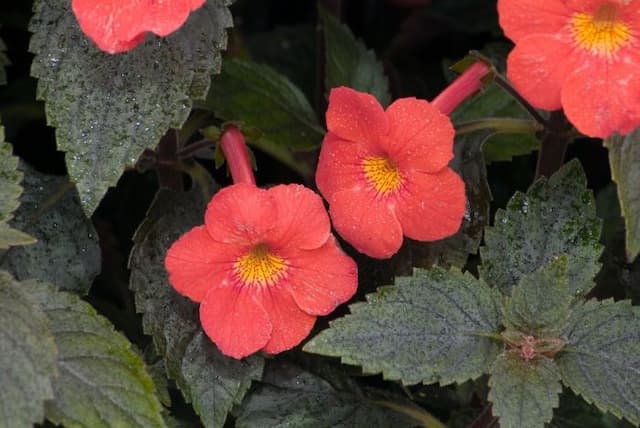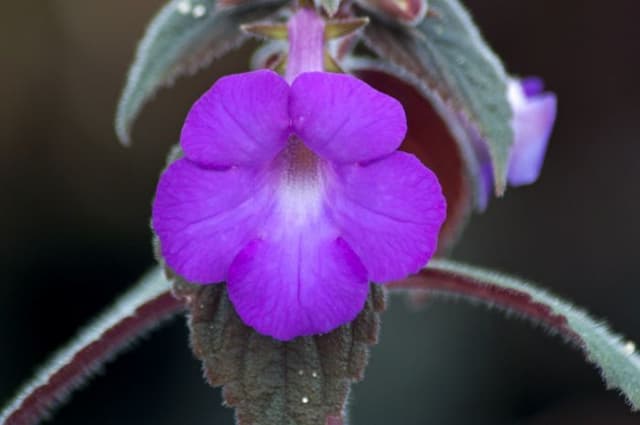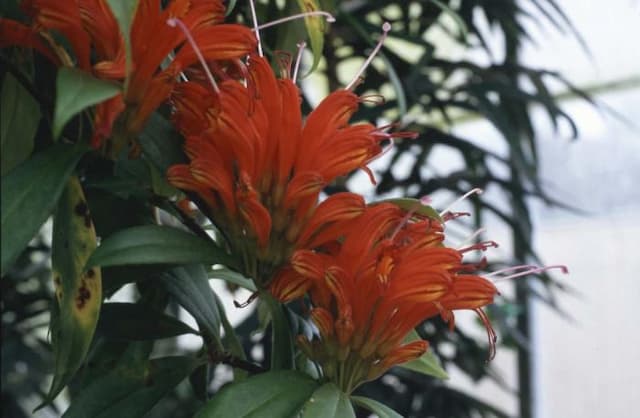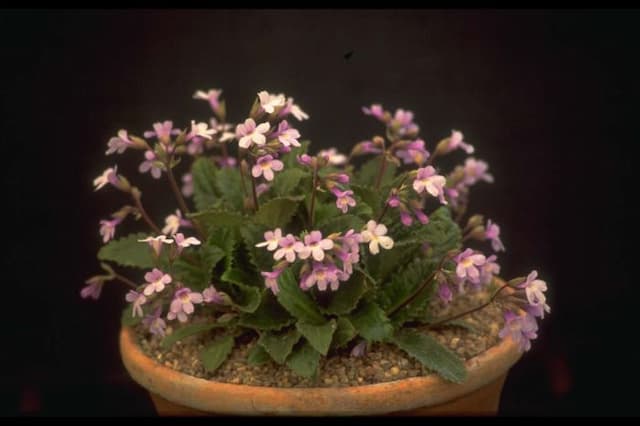Cape Primrose Streptocarpus 'Denim'

ABOUT
The Streptocarpus 'Denim', commonly known as Cape Primrose, has a striking appearance that adds a touch of grace to any indoor plant collection. This particular cultivar is noted for its lush, velvety foliage which grows in a rosette pattern. The leaves are elongated and textured, with a deep green color that serves as a backdrop for the flowers. The 'Denim' variety is named for its beautiful blooms that resemble the color of blue denim. These flowers are trumpet-shaped, hanging delicately from slender stalks that rise above the foliage. The petals of the Cape Primrose may showcase various shades of blues and purples reminiscent of well-worn jeans, often complemented with subtle, whitish or yellowish throats that add depth to the flower's appearance. The blooms can be quite plentiful when the plant is well-cared for, creating a dense cluster of color that is truly eye-catching.
About this plant
 Names
NamesFamily
Gesneriaceae.
Synonyms
Cape Primrose, African Violet.
Common names
Streptocarpus 'Denim'
 Toxicity
ToxicityTo humans
The Streptocarpus 'Denim', commonly known as Cape Primrose, is not known to be toxic to humans. If ingested, it typically does not cause any harmful effects or symptoms. However, as with any plant, individual allergic reactions or sensitivities may occur. It's always advisable to keep plants out of the reach of small children who might chew on them, as non-toxic plants can still pose a choking hazard or cause mild stomach upset due to the unusual texture or natural plant compounds.
To pets
The Cape Primrose is not considered toxic to pets, including cats and dogs. If a pet ingests parts of this plant, it is unlikely to cause any severe symptoms of poisoning. However, as with any non-food item, ingestion might lead to digestive upset like vomiting or diarrhea due to irritation of the stomach or intestines. It is always best to prevent pets from eating houseplants to avoid any potential issues.
 Characteristics
CharacteristicsLife cycle
Perennials
Foliage type
Evergreen
Color of leaves
Green
Flower color
Blue
Height
6 inches (15 cm)
Spread
12 inches (30 cm)
Plant type
Herb
Hardiness zones
10
Native area
Africa
Benefits
 General Benefits
General Benefits- Easy Care: Streptocarpus 'Denim' is known for being low maintenance, requiring minimal care to thrive.
- Long Flowering Period: It can bloom for a large part of the year, providing consistent beauty.
- Attractive Foliage: The plant has attractive, textured leaves that add to its ornamental value.
- Compact Growth: Being a small to medium-sized plant, it fits well in smaller spaces and indoor gardens.
- Shade Tolerance: This plant can grow in areas of partial shade, making it versatile in terms of placement.
- Variety of Colors: It offers a range of flower colors, offering options to suit different aesthetic preferences.
- Non-Toxic: Streptocarpus is non-toxic to pets and children, making it a safe choice for a household plant.
 Medical Properties
Medical PropertiesThis plant is not used for medical purposes.
 Air-purifying Qualities
Air-purifying QualitiesThis plant is not specifically known for air purifying qualities.
 Other Uses
Other Uses- Crafting Botanical Jewelry: The vibrant blue blooms of the Streptocarpus can be pressed and preserved in resin to create unique, nature-inspired necklaces, earrings, or bracelets.
- Photography Subjects: The denim-like petals provide an attractive contrast for macro photography or botanical illustrations, attracting both amateur and professional photographers.
- Teaching Tools: Streptocarpus plants can be used in educational settings to teach about plant biology, hybridization, and horticulture due to their interesting characteristics and variety.
- Art Inspiration: The textured appearance and rich color of the flowers may inspire painters or textile designers when creating new work with a botanical theme.
- Fragrance Production: While primarily ornamental, if the Streptocarpus variety has a notable scent, it could be used in the crafting of botanical perfumes or scented sachets for drawers and closets.
- Theme Gardens: Streptocarpus could be a highlight in a denim or blue-colored theme garden, where all plants exhibit blue hues, adding to a cohesive visual experience.
- Floral Arrangements: Fresh flowers or the whole plant can add an uncommon and striking look to indoor floral arrangements or bouquets.
- Habitat Creation: When planted outdoors in suitable climates, Streptocarpus plants can provide nectar for bees and other pollinators, thus contributing to the health of the local ecosystem.
- Seasonal Decor: The plant's blooms can be matched with seasonal decor, particularly in settings where a blue color scheme is preferred for events or celebrations.
- Collector's Specimen: Due to the range of patterns and colors available within the Streptocarpus genus, the plant can be cultivated as a collector's item among plant enthusiasts.
Interesting Facts
 Feng Shui
Feng ShuiThe Cape Primrose is not used in Feng Shui practice.
 Zodiac Sign Compitability
Zodiac Sign CompitabilityThe Cape Primrose is not used in astrology practice.
 Plant Symbolism
Plant Symbolism- Resilience: Streptocarpus, commonly known as Cape Primrose, often symbolizes resilience due to its ability to thrive in indirect sunlight and with minimal water, representing the ability to withstand difficult conditions.
- Enduring Beauty: Cape Primrose flowers have a long blooming period, which symbolizes lasting beauty and the capacity to remain attractive over time.
- Adaptability: The Cape Primrose's adaptability to various indoor environments makes it a symbol of flexibility and the ability to change according to circumstances.
 Water
WaterThe Cape Primrose should be watered when the top inch of soil feels dry to the touch, which is typically once a week, but this can vary depending on environmental conditions such as temperature and humidity. It's important to use lukewarm water and water the plant thoroughly until water runs out of the drainage holes, using approximately one-eighth to one-quarter of a gallon of water, depending on the size of the pot. Allow the plant to drain fully, as standing water in the saucer can lead to root rot. It's crucial to maintain a balance and never let the soil become completely dry or waterlogged.
 Light
LightCape Primroses thrive in bright, indirect light. The best spot would be a north- or east-facing window where they receive gentle morning sunlight and diffused light throughout the day. Direct afternoon sun can be too harsh and may scorch the leaves, so it's best to avoid placing them in direct southern exposure without some shading.
 Temperature
TemperatureCape Primroses prefer a temperature range between 60 and 75 degrees Fahrenheit for optimal growth. They can survive short periods in temperatures as low as 50 degrees Fahrenheit and as high as 80 degrees Fahrenheit, but prolonged exposure to extremes can stress the plant. The ideal conditions involve consistent temperatures with minimal fluctuations, avoiding drafts and direct heat sources.
 Pruning
PruningCape Primroses benefit from pruning to remove old or yellowing leaves and spent flower stalks, encouraging new growth and a tidier appearance. This should be done as needed throughout the year, with more extensive pruning best performed after the main flowering period. Pinching off the tips of new growth can also promote bushier plants.
 Cleaning
CleaningAs needed
 Soil
SoilCape Primrose 'Denim' thrives in a loose, well-draining soil mixture with high organic matter, such as a blend of peat, perlite, and vermiculite. The soil pH should ideally be slightly acidic to neutral, ranging from 6.0 to 7.0.
 Repotting
RepottingCape Primrose 'Denim' should be repotted every 12 to 18 months, or when it becomes root-bound. It's important to use fresh soil mix when repotting to replenish nutrients.
 Humidity & Misting
Humidity & MistingCape Primrose 'Denim' prefers moderate to high humidity levels, with ideal range between 50% to 60%. A humidifier or pebble tray can help maintain these conditions indoors.
 Suitable locations
Suitable locationsIndoor
Keep Cape Primrose 'Denim' in bright, indirect light with moist soil.
Outdoor
Shelter Cape Primrose 'Denim' from direct sun; keep in a warm, shaded spot.
Hardiness zone
10-11 USDA
 Life cycle
Life cycleCape Primrose 'Denim' begins its life cycle as a seed, which when sown, will germinate in warm, moist conditions, typically taking several weeks to sprout. Once the seedling emerges, it enters the vegetative growth phase, developing foliage and a healthy root system. When mature enough, and with adequate light and care, Cape Primrose 'Denim' will progress to the flowering stage, producing its distinctive blue denim-like blossoms. Following the flowering period, if pollinated, the plant may produce seed pods that, upon maturing, will release seeds and potentially start a new generation. Periodically throughout its life, the plant will enter stages of rest, particularly in cooler temperatures or less favorable conditions, where growth and flowering may diminish. With good care, Cape Primrose 'Denim' can live and thrive for several years as a perennial, going through repeated cycles of growth and dormancy.
 Propogation
PropogationPropogation time
Spring-Early Summer
Streptocarpus 'Denim', commonly known as Cape Primrose, is best propagated by leaf cuttings, a simple and efficient method to create new plants. This is typically done in the spring or early summer when the plant's growth is most active. To propagate, a healthy, mature leaf is selected and cut across the width into sections, each about 2 inches (approximately 5 centimeters) long. The cuttings are then placed in a moist, well-draining potting mix, ensuring that the cut edge is in contact with the soil. Covering the pot with a plastic bag can help maintain humidity, which is beneficial for root development. Within a few weeks, new shoots should emerge from the base of the cuttings, and once these have grown sufficiently, they can be potted on as separate plants.









